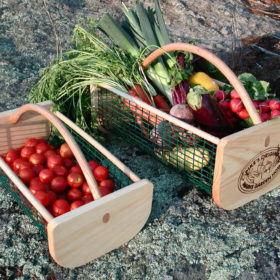Vegetable Harvesting Guide

Harvesting vegetables from the garden is one of the most rewarding and tasty experiences for any gardener. Knowing when to harvest is just as important as knowing how to grow them! Every vegetable it’s own window of opportunity for harvesting. Sometimes it’s hard to know exactly when is the best time to harvest these vegetables. Harvesting too early can lead to a lack in taste and nutrients but harvesting too late can lead to diseases and bad flavor!
Below is a table to help you know the best times to harvest your fruits and vegetables.
| Vegetable | When to Harvest |
| Beans | Beans are most tender and less stringy when harvested when the beans are small. If possible aim for beans the size of tic tacs. After this stage beans become fibrous and more starchy. |
| Beets | Most people are use to large, grocery store size beets. These are large because weight matters in the grocery. Truth is, beets are best tasting when harvested between 1-3″ in diameter. Harvest spring beets before weather gets too hot and fall before first hard freeze. Fall beets are known for best flavor due to cold weather producing a high sugar content. |
| Broccoli | Harvest main (terminal) head when florets are tight and dark green. Do not let any flowers start to open. This will lead to bitterness flavor. Some varieties produce good side shoots that can be harvested before flowers start to open. Broccoli can be grown in both the spring and fall but has a more sweet flavor in fall. |
| Brussel Sprouts | Removing the lowest leaves from the stalk will improve sprout size. Harvest sprouts when firm and close to 1″ in diameter. Fall frost improves flavor but should all be harvested before hard frost. |
| Cabbage | Harvest when heads are solid and size of bowling ball. Varieties will vary in size. Prevent head splitting by pulling cabbage vertically until main root breaks. Cabbage can be stored for a while before eating. Gets more sweet during storage. |
| Carrots | Carrots are most tender and flavorful when harvested at 1-2″ thick at the head. Spring carrots should be harvested before summer heat (July). Fall carrots should be harvested before ground freezes but some varieties can be stored over-winter if mulch is applied. |
| Cauliflower | Cauliflower is best when heads are tight and white. Harvest before head turns yellow and grainy. |
| Chard | Break off outer leaves of chard for continual harvest from summer through fall. |
| Corn | Corn should be fully mature before harvest. Silks from top of corn should be dark and dry to touch. Kernels should be soft and break when pressed on. Pull a test corn off and husk. If ready then harvest what you need to cook within a couple days for best flavor. |
| Cucumbers | Cucumbers are tender and best when harvested before maturity. Skin should be green and flesh bright white. Seeds should be immature and not fully developed. Most varieties of cucumbers are ready when 2″ in diameter. |
| Eggplant | Eggplants should be fully grown with bright and shinny skin. Skin should be soft to touch. When eggplant is dull, hard and has brown seeds it’s over-mature. |
| Lettuce | Leaf lettuce varieties can provide continual harvest by cutting the outer leaves when adequate size. Head lettuce should be firm and crisp. Do not let lettuce bolt. Harvest at first signs of bolting. |
| Melons | One of the hardest fruits to known when mature. Melons should easily break away from vine. If it does not it is not ready. The skin netting turns from green to beige. Ends of the melon should be soft to touch and smell sweet. |
| Okra | Harvest okra pods when they are small. 2-3″ pods are the most tender with best flavor. When pods get larger they are tough and woody. |
| Onions | When tops have fallen over and necks are shriveled onions are ready to harvest. |
| Peas | Garden peas should be harvested when peas have filled out and before any yellowing occurs. Snow peas should be harvested when pod is full size but before peas develop. |
| Peppers | Harvest when peppers are firm and full size. If red fruits are desired, then leave on plant until color develops. Red fruits have more spice and tenderness. |
| Pumpkins | Mature pumpkins will have a hard skin when mature. Harvest at variety size. |
| Radish | Radish is best harvested at .5-1″ in diameter. Harvest spring radish before it gets too hot (July). Fall radishes should be harvested before ground freezes. |
| Spinach | When outer leaves are large enough for use they should be continually harvested. Entire plant can also be harvested at once. |
| Squash | Summer squash is best harvested young and tender. Outside skin should be soft. Winter squash should have a hard outside skin. Harvest winter squash before hard frost. |
| Tomatoes | Tomatoes will turn from green to red. When skin is soft and fruit is uniformly red it’s ready for harvest. If fruit must be harvested while green it is best to store wrapped in newspaper. |
